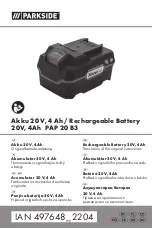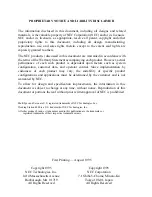
EXPORT POWERDRIVE CHARGER (ONBOARD)
Charger Operation
Page 4-6
2008 Export Battery Charger Maintenance and Service Manual
4
3. Monitor the ammeter for the correct charge rate. The initial charge rate will vary from 15 to 19 amps,
depending upon the condition and depth of discharge of the batteries. Slight variations in the initial
charge rate may also result from AC line input voltages that are higher or lower than the nominal input
voltage. Higher AC line voltages increase the initial charge rate while lower AC line voltages reduce the
initial charge rate.
4. Monitor the ammeter. Under normal operating conditions (when the charger is on and the batteries are
discharged), the charger will shut off in order to run a self-diagnostic program (ammeter will drop to zero)
one hour and two hours into the charge cycle.
See following CAUTION and NOTE.
CAUT ION
• Do not connect an external charger to the receptacle of a vehicle equipped with an onboard
charger while the onboard charger is activated. Charging overload will damage the onboard
computer and may cause battery damage.
NOTE:
If the batteries are in a fully charged state and the vehicle has not been driven, the onboard com-
puter will not perform the self-diagnostic test after the charge cycle starts.
Batteries should be put on charge at the end of each day even if the vehicle has been used for only
a short amount of time (even if for only 10 minutes).
When air temperatures fall below 65 °F (18.3 °C), batteries charged in unheated areas should be
placed on charge as soon as possible after use. Cold batteries require more time to fully charge.
New batteries will not deliver their full range until the vehicle has been driven and recharged from
20 to 50 times.
Vehicles should be restricted to 40 to 50 energy units of discharge (or 36 holes of golf) between
charges until the batteries have been properly seasoned (20 to 50 charge cycles). For maximum
battery life, Club Car recommends that electric vehicles always be recharged after 40 to 50 energy
units of discharge or each night in order to avoid deep discharging the batteries. Charging between
rounds will also extend battery life; use the CDM (Communication Display Module) (CCI P/N
101831801).
See Communication Display Module in Section 11 of the appropriate mainte-
nance and service manual.
TESTING CHARGER OPERATION
1. Connect the AC power supply cord to an electrical outlet. The charger relay should not close immedi-
ately, but should close with an audible click after a delay of 2 to 15 seconds.
See following NOTE.
NOTE:
Monitor the charge cycle to make sure the charger turns off properly. If the charge cycle is inter-
rupted, and the batteries are less than 90% charged, the battery warning light will illuminate inter-
mittently.
See Battery Warning Light on page 4-2.
2. If the charger does not operate exactly as described above, refer to the wiring diagram and make sure
that the vehicle is wired correctly
(Figure 4-2, Page 4-3)
and that the internal charger wiring is correct
(Figure 4-5, Page 4-7)
.
















































